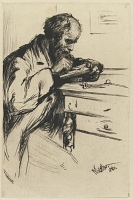Etchings Institutions search term: grolier club
Riault (The Wood Engraver) | ||
| Number: | 69 | |
| Date: | 1860 | |
| Medium: | drypoint | |
| Size: | 230 x 154 mm | |
| Signed: | 'Whistler.' at lower right | |
| Inscribed: | '1860.' at lower right | |
| Set/Publication: | 'Cancelled Plates', 1879 | |
| No. of States: | 4 | |
| Known impressions: | 22 | |
| Catalogues: | K.65; M.65; T.58; W.62 | |
| Impressions taken from this plate (22) | ||
PUBLICATION
EXHIBITIONS
 ). 17
). 17
A few years later, Samuel Putnam Avery (1822-1904) lent an impression - a 'Superb proof' according to the catalogue - to the Union League Club in New York in 1881 (
 ). 18
). 18
Howard Mansfield (1849-1938) helped select exhibits, including 'Riault', for the World's Columbian Exposition in Chicago in 1893. 19 He lent his own impression to an exhibition organised by the Caxton Club in Chicago in 1900 (
 ) and to the Whistler Memorial show in Boston in 1904. 20 Two states were exhibited by H. Wunderlich & Co. in New York in 1898 and bought by Charles Lang Freer (1856-1919) (
) and to the Whistler Memorial show in Boston in 1904. 20 Two states were exhibited by H. Wunderlich & Co. in New York in 1898 and bought by Charles Lang Freer (1856-1919) ( ,
,  ). 21
). 21
Finally impressions were shown at the principal Memorial Exhibitions including the Grolier Club, New York in 1904 and London Memorial Exhibition in 1905. 22
17: Liverpool 1874 (cat. no. 484); see REFERENCES; EXHIBITIONS.
18: New York 1881 (cat. no. 88).
19: 10 January 1893, GUW #04000.
20: Chicago 1900 (cat. no. 57); Boston 1904 (cat. no. 55).
21: New York 1898 (cat. no. 59).
22: New York 1904a (cat. nos. 63a,b); London Mem. 1905 (cat. no. 62)
SALES & COLLECTORS
23: 'English Etching', The Standard, London, 25 April 1878, p. 2 (GUL PC1/94).
 ); it was exhibited in 1874 in Liverpool with the collection of James Anderson Rose (1819-1890), and sold at auction in 1876; it was, as Wedmore stated, acquired by Samuel Putnam Avery (1822-1904), who eventually left it with the rest of his collection to form the core of the print collection on New York Public Library.
); it was exhibited in 1874 in Liverpool with the collection of James Anderson Rose (1819-1890), and sold at auction in 1876; it was, as Wedmore stated, acquired by Samuel Putnam Avery (1822-1904), who eventually left it with the rest of his collection to form the core of the print collection on New York Public Library.24: Wedmore 1886 A (cat. no. 62).
 ,
,  ).
).25: 26 November 1890, GUW #03992.
26: 23 August 1902 , GUW #04012.
 ), as did Thomas Glen Arthur (1858-1907) (
), as did Thomas Glen Arthur (1858-1907) ( ). George Aloysius Lucas (1824-1909) bought a set (
). George Aloysius Lucas (1824-1909) bought a set ( ) as did Boston Public Library (
) as did Boston Public Library ( ). Freer bought a set from Knoedler & Co. in 1893 (
). Freer bought a set from Knoedler & Co. in 1893 ( ). Another set, acquired by J. Littauer (fl. 1896), Munich, was sold to the Hamburger Kunsthalle in 1896 (
). Another set, acquired by J. Littauer (fl. 1896), Munich, was sold to the Hamburger Kunsthalle in 1896 ( ).
). ). She acquired another set, trimmed the impressions and stuck them on the envelopes containing the copper plates (i.e.
). She acquired another set, trimmed the impressions and stuck them on the envelopes containing the copper plates (i.e.  ).
).27: Sotheby's, London, 13 December 1889 (lot 787 or 789)
